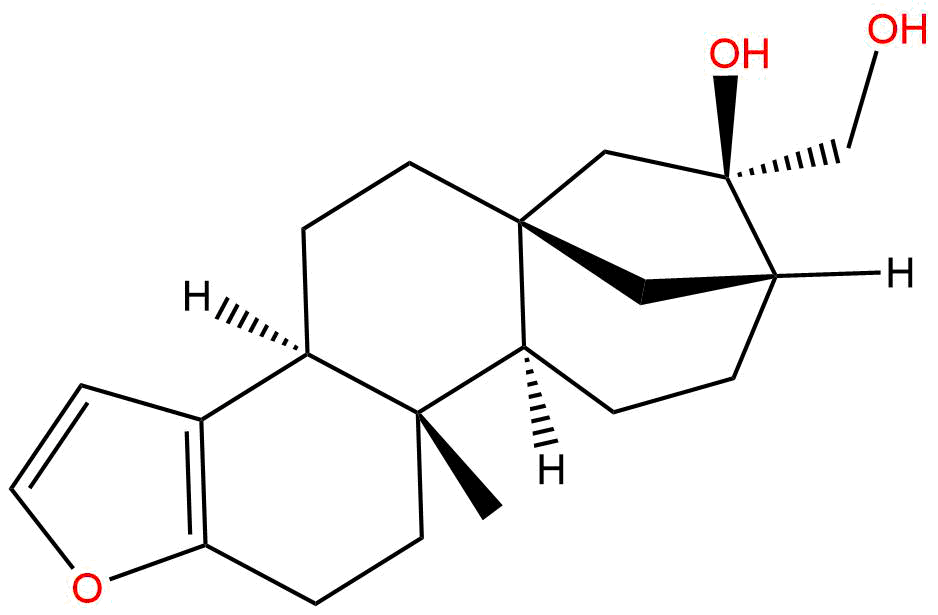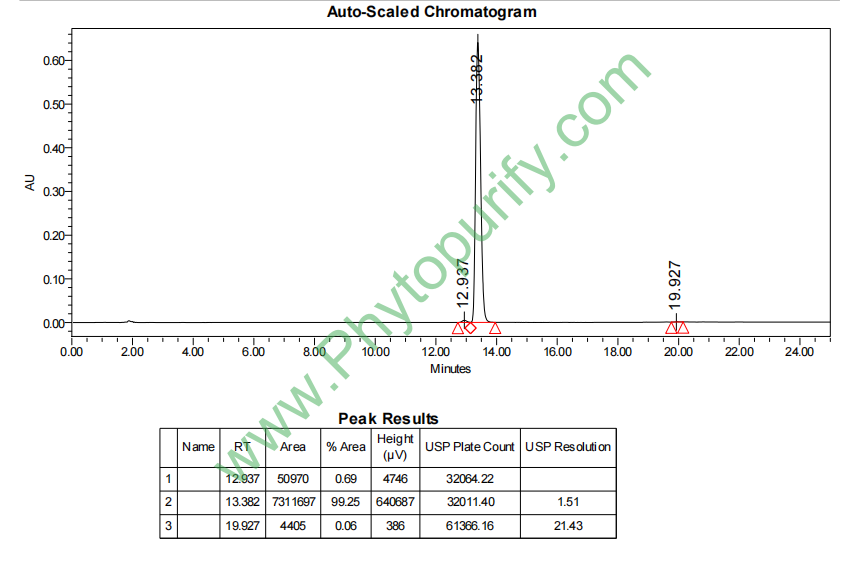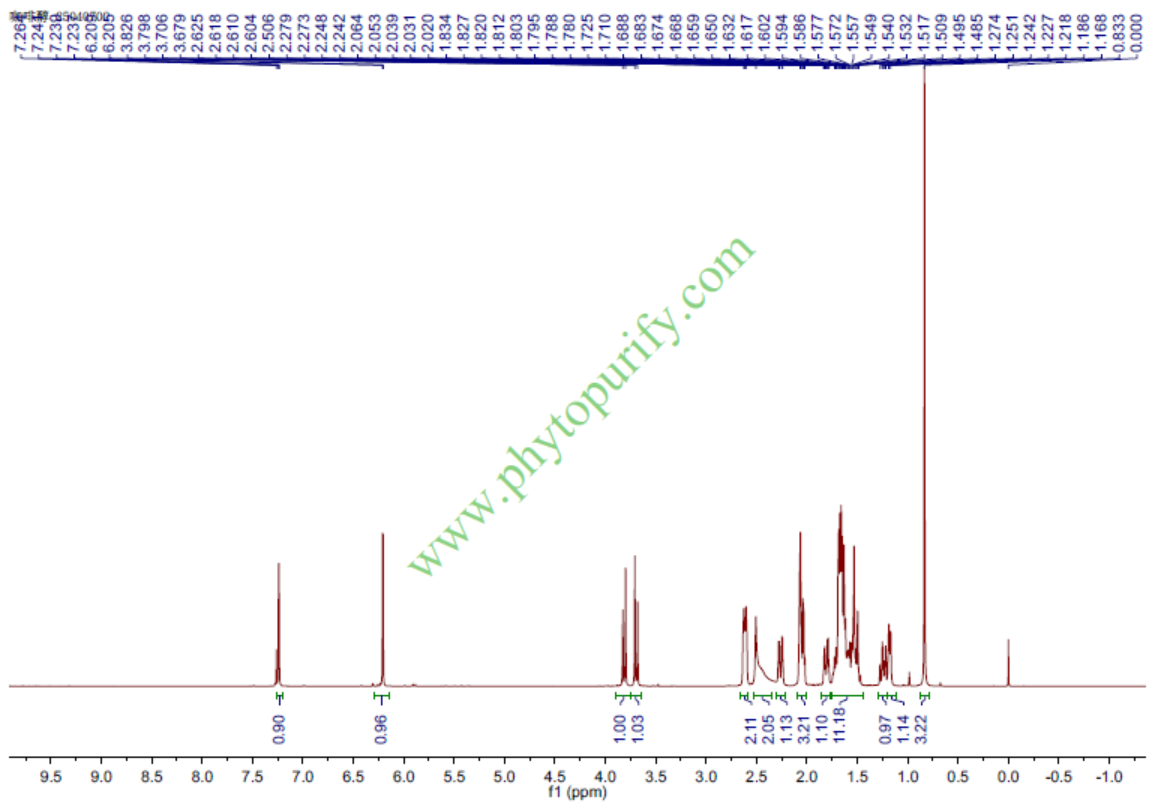
CafestolCAS No.:469-83-0
|
||||||||||
 |
|
|
||||||||

| Catalogue No.: | BP1763 |
| Formula: | C20H28O3 |
| Mol Weight: | 316.441 |
Product name: Cafestol
Synonym name: Cafesterol; Coffeol
Catalogue No.: BP1763
Cas No.: 469-83-0
Formula: C20H28O3
Mol Weight: 316.441
Botanical Source: Coffea Bean
Physical Description:
Type of Compound:
Purity: 95%~99%
Analysis Method: HPLC-DAD or/and HPLC-ELSD
Identification Method: Mass, NMR
Packing: Brown vial or HDPE plastic bottle
The product could be supplied from milligrams to grams. Inquire for bulk scale.
We provide solution to improve the water-solubility of compounds, thereby facilitating the variety of activity tests and clinic uses.
For Reference Standard and R&D, Not for Human Use Directly.
Description:
Cafestol has anticarcinogenic, peripheral antinociceptive and anti-inflammatory activities, it inhibits Cyclic-Strain-induced interleukin-8, intercellular adhesion molecule-1, and monocyte chemoattractant protein-1 production in vascular endothelial cells. Cafestol is a novel extracellular signal-regulated kinase inhibitor with AP-1-targeted inhibition of prostaglandin E2 production in lipopolysaccharide-activated macrophages. Cafestol acts as an agonist ligand for both FXR and PXR, and this may contribute to its impact on cholesterol homeostasis. Cafestol has protective effects against the CCl(4)-induced hepatotoxicity, which possibly involve mechanisms related to its ability to block the CYP2E1-mediated CCl(4) bioactivation and free radical scavenging effects. Cafestol has antidiabetic activity, it increases glucose-stimulated insulin secretion in vitro and increases glucose uptake in human skeletal muscle cells. Cafestol also has a weak inhibitory effect on osteoclastogenesis and promotes osteoblast differentiation.
References:
Oxid Med Cell Longev. 2018 Apr 30;2018:7861518.
Cafestol Inhibits Cyclic-Strain-Induced Interleukin-8, Intercellular Adhesion Molecule-1, and Monocyte Chemoattractant Protein-1 Production in Vascular Endothelial Cells.
Moderate coffee consumption is inversely associated with cardiovascular disease mortality; however, mechanisms underlying this causal effect remain unclear. Cafestol, a diterpene found in coffee, has various properties, including an anti-inflammatory property. This study investigated the effect of Cafestol on cyclic-strain-induced inflammatory molecule secretion in vascular endothelial cells.
METHODS AND RESULTS:
Cells were cultured under static or cyclic strain conditions, and the secretion of inflammatory molecules was determined using enzyme-linked immunosorbent assay. The effects of Cafestol on mitogen-activated protein kinases (MAPK), heme oxygenase-1 (HO-1), and sirtuin 1 (Sirt1) signaling pathways were examined using Western blotting and specific inhibitors. Cafestol attenuated cyclic-strain-stimulated intercellular adhesion molecule-1 (ICAM-1), monocyte chemoattractant protein- (MCP-) 1, and interleukin- (IL-) 8 secretion. Cafestol inhibited the cyclic-strain-induced phosphorylation of extracellular signal-regulated kinase and p38 MAPK. By contrast, Cafestol upregulated cyclic-strain-induced HO-1 and Sirt1 expression. The addition of zinc protoporphyrin IX, sirtinol, or Sirt1 silencing (transfected with Sirt1 siRNA) significantly attenuated Cafestol-mediated modulatory effects on cyclic-strain-stimulated ICAM-1, MCP-1, and IL-8 secretion.
CONCLUSIONS:
This is the first study to report that Cafestol inhibited cyclic-strain-induced inflammatory molecule secretion, possibly through the activation of HO-1 and Sirt1 in endothelial cells. The results provide valuable insights into molecular pathways that may contribute to the effects of Cafestol.
Biol Pharm Bull. 2010;33(1):128-32.
Cafestol, a coffee-specific diterpene, is a novel extracellular signal-regulated kinase inhibitor with AP-1-targeted inhibition of prostaglandin E2 production in lipopolysaccharide-activated macrophages.
Coffee is a popular beverage worldwide with various nutritional benefits. Diterpene Cafestol, one of the major components of coffee, contributes to its beneficial effects through various biological activities such as chemopreventive, antitumorigenic, hepatoprotective, antioxidative and antiinflammatory effects.
METHODS AND RESULTS:
In this study, we examined the precise molecular mechanism of the antiinflammatory activity of Cafestol in terms of prostaglandin E(2) (PGE(2)) production, a critical factor involved in inflammatory responses. Cafestol inhibited both PGE(2) production and the mRNA expression of cyclooxygenase (COX)-2 from lipopolysaccharide (LPS)-treated RAW264.7 cells. Interestingly, this compound strongly decreased the translocation of c-Jun into the nucleus and AP-1 mediated luciferase activity. In kinase assays using purified extracellular signal-regulated kinase 2 (ERK2) or immunoprecipitated ERK prepared from LPS-treated cells in the presence or absence of Cafestol, it was found that this compound can act as an inhibitor of ERK2 but not of ERK1 and mitogen-activated protein kinase kinase 1 (MEK 1).
CONCLUSIONS:
Therefore our data suggest that Cafestol may be a novel ERK inhibitor with AP-1-targeted inhibitory activity against PGE(2) production in LPS-activated RAW264.7 cells.
Biofactors. 2015 Jul-Aug;41(4):222-31.
Cafestol has a weaker inhibitory effect on osteoclastogenesis than kahweol and promotes osteoblast differentiation.
Bone homeostasis is regulated by a balance between osteoclast (OCL)-mediated bone resorption and osteoblast (OBL)-mediated bone formation. Thus, developing a compound that simultaneously inhibits OCL function and promotes OBL function would be useful as a new medical therapy for bone diseases.
METHODS AND RESULTS:
Here, we examined the effects of Cafestol, a coffee diterpene, on the differentiation of OCLs and OBLs. Cafestol prevented OCL formation in a dose-dependent manner and suppressed the bone-resorbing activity of OCLs. Interestingly, the viability of OCLs treated with 10-50 μM Cafestol was significantly higher than that of untreated cells. At the molecular level, Cafestol markedly decreased RANKL-induced phosphorylation of extracellular signal-regulated kinase (Erk) and inhibitor of nuclear factor kappa B alpha (IκBα). Compared to kahweol, another coffee-specific diterpene, the inhibitory effects of Cafestol were milder on OCL differentiation, and Cafestol and kahweol showed different characteristics in induction of the phase ΙΙ antioxidant enzymes and sensitivities in nuclear factor-erythroid 2-related factor 2 (Nrf2)-deficient BMMs. In addition to inhibiting OCLs, Cafestol enhanced the differentiation of osteoblastic cells by increasing the mRNA levels of differentiation markers.
CONCLUSIONS:
Thus, Cafestol inhibits OCL differentiation and promotes OBL differentiation, suggesting that Cafestol may be a novel agent for bone diseases.
HPLC of Cafestol

HNMR of Cafestol
